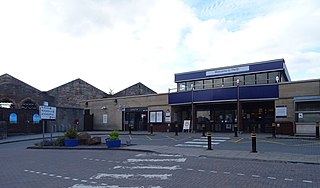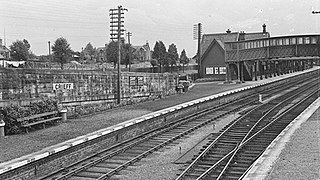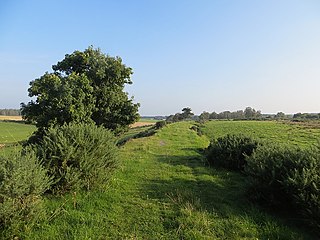Related Research Articles

The Highland Railway (HR) was one of the smaller British railways before the Railways Act 1921, operating north of Perth railway station in Scotland and serving the farthest north of Britain. Based in Inverness, the company was formed by merger in 1865, absorbing over 249 miles (401 km) of line. It continued to expand, reaching Wick and Thurso in the north and Kyle of Lochalsh in the west, eventually serving the counties of Caithness, Sutherland, Ross & Cromarty, Inverness, Perth, Nairn, Moray and Banff. Southward it connected with the Caledonian Railway at Stanley Junction, north of Perth, and eastward with the Great North of Scotland Railway at Boat of Garten, Elgin, Keith and Portessie.

Perth railway station is a railway station located in the city of Perth, Scotland, on the Glasgow to Dundee line, and the Highland Main Line. It is managed by ScotRail, who provide almost all of the services.
The Edinburgh and Glasgow Railway was authorised by Act of Parliament on 4 July 1838. It was opened to passenger traffic on 21 February 1842, between its Glasgow Queen Street railway station and Haymarket railway station in Edinburgh. Construction cost £1,200,000 for 46 miles (74 km). The intermediate stations were at Corstorphine, Gogar, Ratho, Winchburgh, Linlithgow, Polmont, Falkirk, Castlecary, Croy, Kirkintilloch and Bishopbriggs. There was a ticket platform at Cowlairs. The line was extended eastwards from Haymarket to North Bridge in 1846, and a joint station for connection with the North British Railway was opened on what is now Edinburgh Waverley railway station in 1847.

Cowdenbeath railway station is a railway station in the town of Cowdenbeath, Fife, Scotland. The station is managed by ScotRail and is on the Fife Circle Line, 22+1⁄2 miles (36.2 km) north of Edinburgh Waverley.

The Dundee and Newtyle Railway opened in 1831 and was the first railway in the north of Scotland. It was built to carry goods between Dundee and the fertile area known as Strathmore; this involved crossing the Sidlaw Hills, and was accomplished with three rope-worked inclined planes. Newtyle was simply a remote railhead, and the anticipated traffic volumes were not achieved, the inclines incurred heavy operating costs, and the railway never made money.

Crieff was a junction railway station at Crieff, Perth and Kinross, Scotland. It was where the Crieff Junction Railway, Crieff & Methven Railway and the Comrie, St Fillans & Lochearnhead Railway met.
The Scottish Central Railway was formed in 1845 to link Perth and Stirling to Central Scotland, by building a railway line to join the Edinburgh and Glasgow Railway near Castlecary.
There have been several railway stations serving the town of Newburgh, Fife. The original was opened on 17 May 1848 by the Edinburgh and Northern Railway, on their line from Ladybank to Hilton Junction, near Perth. This station lasted until August 1906, when a larger replacement station was opened.

Glenfarg is a village in the Ochil Hills in Perth and Kinross, Scotland. Until 14 June 1964, the village had a railway station, Glenfarg railway station, on the main line between Perth and Edinburgh via Kinross. Although not recommended for closure under the Beeching Axe, the line nevertheless closed to passengers and freight on 5 January 1970, resulting in slower passenger services to Perth via longer routes. The former railway line is now the route of the M90 motorway, which runs along the eastern periphery of the village. At its peak, the village became a popular holiday destination, boasting 4 hotels. Services in the village include a church, small shop, tennis courts, riding school and a primary school with nursery.

The Inverness and Perth Junction Railway (I&PJR) was a railway company that built a line providing a more direct route between Inverness and the south for passengers and goods. Up to the time of its opening, the only route was a circuitous way through Aberdeen. The I&PJR was built from a junction with the friendly Inverness and Aberdeen Junction Railway at Forres to the Perth and Dunkeld Railway at Dunkeld.
The Dundee and Arbroath Railway was an early railway in Scotland. It opened in 1838, and used the unusual track gauge of 5 ft 6 in (1,676 mm). In 1848 it changed to standard gauge and connected to the emerging Scottish railway network.
The Dundee and Perth Railway was a Scottish railway company. It opened its line in 1847 from Dundee to a temporary station at Barnhill and extended to Perth station in 1849. It hoped to link with other railways to reach Aberdeen and changed its name to the Dundee and Perth and Aberdeen Railway Junction Company, but this early attempt was frustrated, and for some years it failed to make a physical connection with other railways in Dundee.
The Inverness and Aberdeen Junction Railway (I&AJR) was a railway company in Scotland, created to connect other railways and complete the route between Inverness and Aberdeen. The Inverness and Nairn Railway had opened to the public on 7 November 1855 and the Great North of Scotland Railway (GNoSR) was building from Aberdeen to Keith. The I&AJR opened, closing the gap, on 18 August 1856.
The Edinburgh and Northern Railway was a railway company authorised in 1845 to connect Edinburgh to both Perth and Dundee. It relied on ferry crossings of the Firth of Forth and the Firth of Tay, but despite those disadvantages it proved extremely successful. It took over a short railway on the southern shore of the Forth giving a direct connection to Edinburgh, and it changed its name to the Edinburgh, Perth and Dundee Railway.
The Banff, Portsoy and Strathisla Railway was a Scottish railway company that connected the Aberdeenshire ports of Banff and Portsoy with the main line of the Great North of Scotland Railway (GNoSR) main line at Grange, a place some distance east of Keith. The railway opened in 1859, and was renamed the Banffshire Railway in 1863 when the GNoSR began running services.
The Brechin and Edzell District Railway was a local line in Scotland connecting Edzell, then a developing tourist centre, to the nearby main population centre of Brechin, where there was a branch of the Caledonian Railway. The short line opened in 1896, and it was worked by the Caledonian Railway.
The Railways of Kinross were a local network of three rural railways which made the town of Kinross in Scotland their objective in the 1850s.
The Forth Bridge approach railways were railway lines constructed in the period 1887 to 1890 to form new main lines on the opening of the Forth Bridge at the Queensferry crossing. Until then, only local branch lines approached the location. The North British Railway built new main lines and upgraded some existing lines.
Mawcarse railway station served the hamlet of Mawcarse, Perth and Kinross, Scotland from 1858 to 1964 on the Fife and Kinross Line.
Milnathort railway station served the town of Milnathort, Perth and Kinross, Scotland, from 1858 to 1964 on the Fife and Kinross Line.
References
- ↑ Quick, M E (2002). Railway passenger stations in England, Scotland and Wales - a chronology. Richmond: Railway and Canal Historical Society. p. 188. OCLC 931112387.
- ↑ "Proposals for direct Perth to Edinburgh train link to be considered by Transport Scotland". www.railtechnologymagazine.com. Retrieved 23 October 2020.